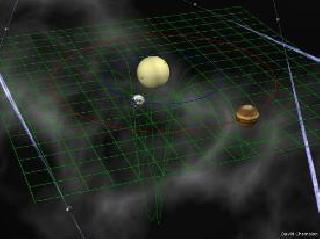
The Sun, Earth and Jupiter orbit a common barycentre. Photo by: D. Champion, MPIfR.
CANBERRA, AUSTRALIA (BNS): An international CSIRO-led team of astronomers has developed a new way to weigh the planets in our Solar System – using radio signals from the small spinning stars called pulsars.
Observations of a set of four of these pulsars, were used to calculate the masses of Mercury, Venus, Mars, Jupiter and Saturn, including their moons, says an international team led by Germany's Max Planck Institut für Radioastronomie.
"This is first time anyone has weighed entire planetary systems – planets with their moons and rings," team leader Dr David Champion from Germany’s Max-Planck-Institut für Radioastronomie, was quoted as saying in the Commonwealth Scientific and Industrial Research Organisation (CSIRO) news release.
Until now, astronomers have weighed planets by measuring the orbits of their moons or of spacecraft flying past them. That’s because mass creates gravity, and a planet’s gravitational pull determines the orbit of anything that goes around it – both the size of the orbit and how long it takes to complete.
The new method is based on corrections astronomers make to signals from pulsars – small spinning stars that deliver regular ‘blips’ of radio waves.
The Earth is travelling around the Sun, and this movement affects exactly when pulsar signals arrive here.
To remove this effect, astronomers calculate when the pulses would have arrived at the Solar System’s centre of mass, or barycentre, around which all the planets orbit.
Because the arrangement of the planets around the Sun changes all the time, the barycentre moves around too.
To work out its position, astronomers use both a table (called an ephemeris) of where all the planets are at a given time, and the values for their masses that have already been measured.
"if these figures are slightly wrong, and the position of the barycentre is slightly wrong, then a regular, repeating pattern of timing errors appears in the pulsar data but if all are correct then the timing errors disappear. This is the feedback process that the astronomers have used to determine the planets’ masses," CSIRO Astronomy and Space Science (CASS) researcher, Dr Dick Manchester said, according to the release.
The new technique is quite precise sensitive to about 0.003 per cent of Earth's mass, and a tenth of a millionth of Jupiter's mass. And in the future combining pulsar timing with existing data sets will lead to even greater precision, the astronomers say.
In fact, the new method is based on corrections the astronomers make to signals from pulsars -- small spinning stars that deliver regular "blips" of radio waves.
 Previous Article
Previous Article Next Article
Next Article












The Indian Air Force, in its flight trials evaluation report submitted before the Defence Ministry l..
view articleAn insight into the Medium Multi-Role Combat Aircraft competition...
view articleSky enthusiasts can now spot the International Space Station (ISS) commanded by Indian-American astr..
view article